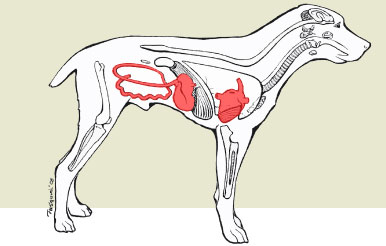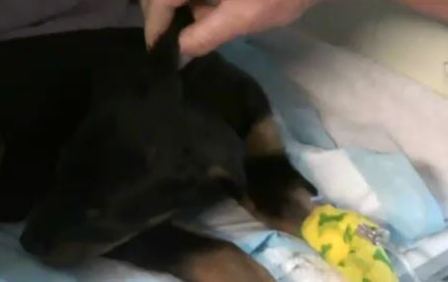Viruses: Parvo Overview
Virus Quicklinks
Cause:
The origin of parvovirus
in dogs is not known, but the
causative virus
is a very resistant one. It can tolerate environmental stress, such as
temperature, common disinfectants and can exist for
months in contaminated compounds.

Parvo Dogs Symptoms Impact the Digestive and Cardiovascular Systems
Symptoms include sudden high fever, diarrhea, lethargy and loss of appetite
Source: Cornell College of Veterinary Medicine
Parvovirus is primarily transmitted through direct contact, but indirect modes of transmission; such as contaminated fomites (any object or substance capable of carrying infectious organisms) have been noted. The feces of infected dogs are the main source of infection and even dogs that have recovered can act as carriers for months.
Once the virus is ingested, it replicates in the lymphoid tissues and is then transmitted to the gastrointestinal tract via blood circulation. It causes severe damage to dividing cells at different sites, mostly in the bone marrow and gastrointestinal tract, leaving dogs with gastrointestinal symptoms and suppressed immune systems.
Clinical signs usually appear after 3–4 days, and the virus passes in the feces within 3–4 weeks of infection. Secondary bacterial agents, most commonly Salmonella, E. coli and Clostridium perfringens, can cause generalized illness by infecting damaged epithelium (lining) in the small intestine. Clinical signs are mostly associated with secondary infections.
Parvo Virus in Puppies
Parvo
virus in puppies
affects puppies between the ages of 6 weeks and 20 weeks.
Toy breeds are particularly vulnerable to the infection. it
usually occurs while the immunity inherited from the mother winds down
and before vaccination takes hold. Unfortunately, the disease
has
a high mortality rates with as many as 48% of puppies not surviving the
disease.

Puppy parvo patient undergoing IV drip which includes minerals, electrolytes and sugar. One test of dehydration, a symptom of puppy parvo, is to gently pull back skin into a fold. If the skin stays up, then the puppy is probably dehydrated and requires fluids.
Source: Dr. Greg DVM
The best protection for puppies is vaccination with the first dose given at 5 weeks of age through 20 weeks of age with annual booster shots. Symptoms of parvo in puppies include refusing milk from the mother and heart related problems in addition to the adult parvo symptoms listed below.
Clinical Signs of Parvo Dogs Infection:
Parvovirus infection remains asymptomatic in infected dogs. The severity of clinical signs is also dependent upon the dose of virus and specie of bacteria that infected a specific dog.
There are two clinical forms of parvo dog infection, one involving the gastrointestinal tract; while the other causes myocarditis. Myocarditis (inflammation of the myocardium, the thickest layer of the heart wall); is only noted in puppies. The gastrointestinal form can cause high mortality in young dogs, estimated at 16–48% in the canine population of those that have contracted the disease. Myocarditis is uncommon now, due to the effective immunization of bitches and young puppies, but can cause pulmonary collapse and cardiac insufficiency in dogs that do contract a severe infection.
The gastrointestinal form and related parvo virus symptoms are most common in young dogs between the ages of 16–20 weeks. Enteritis (inflammation of the small intestine) is the main sign associated with other parvo symptoms such as anorexia (loss of appetite), vomiting, diarrhea, fever and lethargy. Clinical signs may be mild to severe, in which most dogs recover in a few days, while others die within hours after the clinical onset of the disease.
Diagnosis:
Clinical signs for Parvo dogs are usually noticed too late for an effective treatment plan to be implemented. The history and clinical signs can help, but an earlier confirmatory diagnosis is usually required based upon laboratory testing.
Enzyme Linked Immuno Suppressant Assay or “ELISA” testing can help to confirm a diagnosis , but only on the first day clinical signs are observed, as test results may appear negative after the second day.
Upon examination of the blood, it may reveal neutropenia (an abnormal decrease in the number of neutophils/white blood cells), which confirms the presence of the canine parvovirus infection. The serum ALT may also appear elevated with a reduced albumin level in the blood serum.
Confirmation of the parvo virus infection can also be done via anti-body detection and by noting the presence of virus particles in the feces; which can be done with techniques such as immunofluoresence and electron microscopy.
Treatment of Parvo Infection:
No specific treatment is available for the parvovirus infection in dogs. Fluid therapy is considered crucial for dogs upon the clinical onset of the disease. Vomiting and diarrhea can cause severe dehydration and weakness which should be addressed by initiating intravenous fluid therapy, such as by using 5% Ringer’s lactate infusion combined with dextrose and potassium chloride.
Persistent vomiting is a big problem to address in infected dogs, thus anti emetic drugs (anti-vomiting), such as metaclopramide should be added at 2 mg/Kg B.W in infusion.
Vomiting dogs should not be fed orally for at least 24 hours and nutritional components should be administered intravenously. Once the dog feels better, commercially available prescription diets, containing rice with cottage cheese; should be given in small volumes. If this diet is intolerable for the dog, fasting should be continued for another 24–36 hours, depending upon the dog's conditions and improvement.
Routine usage of anti-biotics for secondary bacterial infections in case of Parvo Dogs infection is highly prohibited; as severe pulmonary and cardiac side effects are associated with this mode of treatment. Dogs may die within hours of anti-biotic therapy; therefore, antibiotics should be started only after that course of viral disease is over. Ampicillin or Enrofloxacin are choice anti-biotics for canine parvo and should be used only per the direction of a veterinarian.
There is a homeopathic remedy available that can be used for supportive care, in addition to the base treatment provided by your veterinarian. The role of remedies or natural medicine is to strengthen a dog's own defenses against disease. In the case of parvo, the goal is to reduce or avoid symptoms such as vomiting, diarrhea, and fever while speeding recovery.
One product made for this purpose is Parvo-K , which contains ingredients selected for this purpose. Specific ingredients and their use include Arsenicum alb (digestion), Veratrum alb (firm stools and temperature regulation), Belladonna (temperature regulation and fluid balance), Parvo (homeopathic preparation of the parvo vaccine to boost immune system), Zinigiber (digestive fluid balance) and Agrimonia eup (digestive tract, gallbladder and liver health).
Check with your veterinarian so that he or she can monitor progress and comment on the use of this approach toward a remedy for parvo in addition to other base treatment methods.
Canine Parvo Prevention and Control
Hygienic measures and vaccinations can help in prevention and control. Household bleach should be used for cleaning contaminated areas. Cleaning and the disinfection of equipment, the house and all accessories is necessary to control a Parvo Dog problem.
Vaccination is crucial. Both live and killed vaccines are available, but live attenuated vaccine is highly recommended; as the latest formulated vaccines containing canine parvovirus can immunize dogs against almost all strains of virus. Puppies should be vaccinated between the ages of 5–8 weeks, and this should be repeated based on the puppies immune status. The last vaccine should be delivered between the ages of 16–20 weeks. An annual booster dose is highly recommended to prevent parvo dogs. For more information, download this canine parvo brochure from the American Veterinary Medical Association (PDF).
|
|